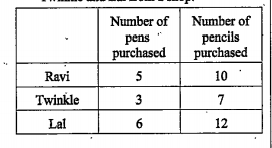If A and B are two events such that A⊂B and P(B)≠0, then which of the following is correct? a)P(A∣B)=P(B)P(A) b)P(A∣B)<P(A) c)P(A∣B)≥P(A) d)None of theseSolution in Malayalam
P(A/B)=P(B)/P(A)
P(AB)<P(A)
P(AB)>P(A)
none of these
The correct Answer is:C
Step by step video, text & image solution for If A and B are two events such that A subset B and P(B) ne 0, then which of the following is correct? a)P(A | B)=(P(B))/(P(A)) b)P(A | B)ltP(A) c)P(A | B) ge P(A) d)None of these by Maths experts to help you in doubts & scoring excellent marks in Class 12 exams.
Topper's Solved these Questions
Similar Questions
Consider the following information regarding the purchase of pens and penciles by the three students Ravi, Twinkle and Lal from a shop.
 Represent the above data in the form of a 3×2 matrix. What does the entry in the 2nd row and in the first column represent?02:07View Solution
Represent the above data in the form of a 3×2 matrix. What does the entry in the 2nd row and in the first column represent?02:07View SolutionLet A be the set of all 50 students of class X in a school. Let f:A→N
be function defined by f(x) = roll numbers of the student x. Show that
f is one-one but not onto01:07View SolutionIf A and B are two events such that A⊂Band P(B)≠0,them which of the following is correct?(A) P(A∣B)=P(B)P(A) (B) P(A∣B)<P(A) (C) P(A∣B)≥P(B) (D) none of these
02:29View SolutionIf A and B are any two events such that P(A)+P(B)−P(AandB)=P(A)? then
(A) P(B∣A)=1
(B) P(A∣B)=1
(C) P(B∣A)=0
(D) P(A∣B)=001:50View SolutionIf A and B are arbitrary events,then a )P(A nn B)>=P(A)+P(B)(b)P(A uu B)<=P(A)+P(B)(c)P(A nn B)=P(A)+P(B)(d) (d)None of these
02:01View Solutionयदि A और B दो घटनाएं इस प्रकार हैं कि P(A∣B)=P(B∣A)≠0 तब
03:47View SolutionA and B are two events such that P(A)≠0. Find P(B/A) if (i) A is a subset of B (ii) A∩B=ϕ
01:39View SolutionIf A and B are two events such that A⊂Band P(B)≠0,them which of the following is correct?
(A) P(A∣B)=P(B)P(A) (B) P(A∣B)<P(A) (C) P(A∣B)≥P(B) (D) none of these01:54View SolutionIf A and B are any two events such that P(A)+P(B)−P(AandB)=P(A)? then(A) P(B∣A)=1 (B) P(A∣B)=1(C) P(B∣A)=0 (D) P(A∣B)=0
02:37View SolutionIf A and B are arbitrary events, then a) P(A∩B)≥P(A)+P(B) (b) P(A∪B)≤P(A)+P(B) (c) P(A∩B)=P(A)+P(B) (d)None of these
01:38View SolutionIf A and B are two events such that P(A)>0 and P(A)+P(B)>1, then P(B/A)≥1−P(B')P(A).
01:54View Solutionਜੇਕਰ A ਅਤੇ B ਦੋ ਘਟਨਾਵਾਂ ਇਸ ਪ੍ਰਕਾਰ ਹਨ ਕਿ P(A∣B)=P(B∣A)≠0 ਤਾਂ:
01:55View SolutionIf A and B are two events, then P(A)+P(B)=2P(A∩B) if and only if
A. P(A)+P(B)=1
B. P(A)=P(B)
C. P(A)=P(B)
D. None of these03:26View SolutionIf A and B are event's such that P(A∣B)=P(B∣A), then A)A⊂B but A≠B B)A=B C)A∩B=ϕ D)P(A)=P(B)
03:13View SolutionIf A and B are two events such that A⊂B and P(B)≠0, then which of the following is correct? a)P(A∣B)=P(B)P(A) b)P(A∣B)<P(A) c)P(A∣B)≥P(A) d)None of these
04:04View SolutionA and B are two events such that P(A) ne 0 . Find P(B | A) , if i) A subset B ii) A nn B=phi
02:05View Solution

